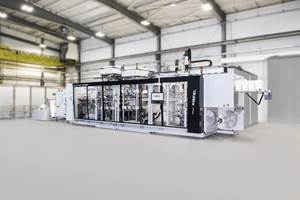Thermoformer’s ‘Black Art’ Legacy Remains Today
While the thermoforming industry has made major strides in moving from black art to science in the last 50 years, there remains an unscientific element to the process that makes it a unique and challenging ┤¾¤¾┤½├¢.
While the thermoforming industry has made major strides in moving from black art to science in the last 50 years, there remains an unscientific element to the process that makes it a unique and challenging ┤¾¤¾┤½├¢. That’s the view of Rick Goldman, president of Mercury Plastics Inc. in Chicago, a custom thermoforming shop founded by his father John in 1955.
“We had more artists back then who had incredible hand and eye skills,” says Goldman. “Many of those craftsmen are gone and we’re more into the science now so we can be more productive and repeatable with our process.” Today, the company’s 60-plus employees have been trained in the latest process and moldmaking technology. Still, Mercury relies to an extent on veteran operators who can dial in settings based on experience and “gut feel” and make adjustments on the fly to maintain a consistent process.
P-O-P signs spur growth
The elder Goldman, who retired last year, was 32 when he opened a ┤¾¤¾┤½├¢ in his garage in 1955. Before that, he had worked at Felsenthal Plastics in Chicago, a molding shop started by his grandfather in the 1890s. Goldman started out using a hand router to make acrylic templates for drafting boards. Later that year, he moved to a 1500-sq-ft space on Diversey St. in downtown Chicago and bought his first AutoVac thermoformer. Some of his first forming jobs were polystyrene and PVC material-handling trays and insulation covers for Motorola transistor radios.
By 1964, Goldman had moved to a new 6000-sq-ft location and had three vacuum formers and two punch presses. Mercury was expanding into what would become a key market area: silk-screened point-of-purchase signs of PS for the liquor and beer industry.
While it specialized in POP signs, Mercury made a conscious effort to remain nimble and diversified. The company expanded into rotary thermoforming because it “couldn’t be competitive forming one sheet at a time,” explains John Goldman. A move into roll-fed continuous forming also spurred strong growth for the company in cosmetic packaging. This diversification meant that Mercury experienced neither economic tailspins nor sharp upturns in its long history. Instead, the Goldmans say the company’s fortunes have been steady as an arrow.
Keeping up on technology
Mercury invested continuously in the latest equipment. But in the old days, money was tight and credit and lease options were nonexistent. “Back then, you had to buy the equipment outright,” recalls John Goldman. “The lack of funds held us back until leasing and credit became available.”
Today, the company’s 150,000-sq-ft plant boasts 30 thermoformers, over a dozen CNC routers, several CNC machining centers, water-cooled aluminum tooling, and a six-color automatic screen printer.
“We’ve always listened to the market and expanded operations and machinery accordingly,” says Rick Goldman. The company held true to that belief even when he thought in the early 1990s that “there was no tolerances our customers needed to hold that required us to invest in CNC routers.” He had to eat his words later.
Since he joined his father in 1977, son Rick has watched customers become more sophisticated and competition more fierce. Product-development cycles have been compressed and pricing pressures have become “incredible.” Years ago, a tooling blueprint was delivered by mail; today, CAD files are e-mailed within minutes.
This has all changed the way suppliers deal with customers, according to Rick Goldman. So-called “relationship buying,” which was the bedrock of ┤¾¤¾┤½├¢ in the 1950s and 1960s, has given way to buying decisions made solely on cost. “You’re not dealing with owners of companies anymore, you’re dealing with purchasing directors and engineers,” says John Goldman.
The younger Goldman believes that Mercury is poised for the future as thermoforming takes expanded roles in large-part manufacturing and as a cost-effective alternative to injection molding. Mercury’s game plan is unchanged from the last 50 years. “Our customers are what we are all about,” says Goldman. “Wherever they’re headed, we’re following.”
Related Content
Upgraded Former is Faster, More Precise
New features reportedly offer more efficient production of trays, containers, hinged boxes, pallets, blisters, lids and technical products.
Read MoreAmcor, Berry Merge in All-Stock Deal
Move unites two complementary ┤¾¤¾┤½├¢es to create a global leader in consumer packaging.
Read MoreA Processor's Perspective: What's Driving Growth in Heavy-Gauge Thermoforming
Key factors for the progress are innovative materials, advanced automation and precision engineering.
Read MoreWinners Announced for SPE Thermoforming 2023 Parts Competition
More than 30 entries were considered, including 10 in the Sustainability category.
Read MoreRead Next
Beyond Prototypes: 8 Ways the Plastics Industry Is Using 3D Printing
Plastics processors are finding applications for 3D printing around the plant and across the supply chain. Here are 8 examples to look for at NPE2024.
Read MoreFor PLASTICS' CEO Seaholm, NPE to Shine Light on Sustainability Successes
With advocacy, communication and sustainability as three main pillars, Seaholm leads a trade association to NPE that ‘is more active today than we have ever been.’
Read MoreMaking the Circular Economy a Reality
Driven by brand owner demands and new worldwide legislation, the entire supply chain is working toward the shift to circularity, with some evidence the circular economy has already begun.
Read More










